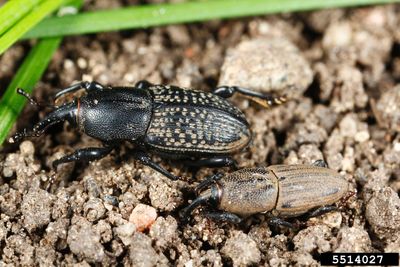What are Billbugs?
You can distinguish billbugs from other lawn pests because their larvae have no legs. These cream-colored, c-shaped grubs are the phase of the life cycle that damages the lawn. You won’t see the grubs unless you dig around the roots and look for them. The adults emerge from the lawn thatch and leaf litter where they spent the winter when temperatures rise about 65 degrees F. (18 C.). You may see them walking around on driveways and sidewalks as they search for a good place to lay their eggs. They dig a little cave in the soil and deposit their eggs. Grubs emerge from the eggs in a week or two.
Controlling Lawn Billbugs
Billbug lawn damage consists of brown dead patches and irregularly shaped bare areas on the soil. It looks a lot like white grub damage. One way to tell the difference is that you can pull dead patches away from the soil, but you can’t roll it up like you can sod damaged by white grubs. You may be able to see little piles of white, sawdust-like frass around the base of grass where billbug grubs have been feeding. The best method of controlling lawn billbugs is to grow a healthy lawn. Fertilize as recommended for the type of turfgrass you are growing. For most species, 1 pound (.5 kg.) of nitrogen per 1,000 square feet four times a year is ideal. Water often so that the lawn never suffers from drought stress. Mow regularly, never removing more than one-third of the length of the blades at a time. Billbugs in the lawn respond well to beneficial nematodes. Follow the label recommendations about timing, application methods and rates. They have a short shelf life, so purchase them when you plan to use them.
